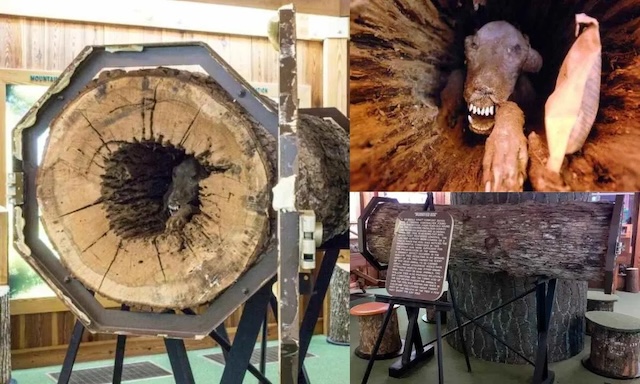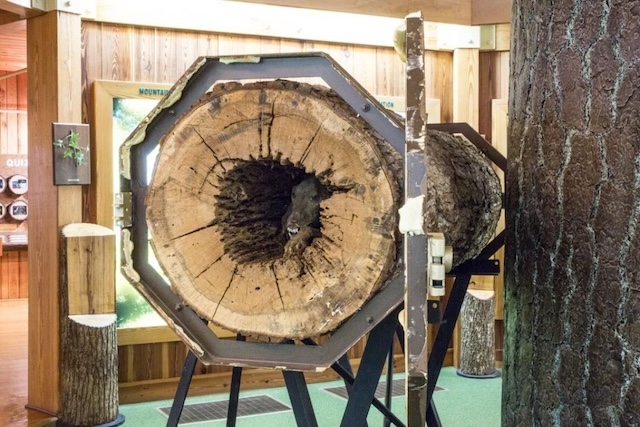In the quiet forests of Georgia during the 1980s, an extraordinary discovery captured the curiosity of scientists and nature enthusiasts alike. Loggers uncovered the mummified remains of a dog lodged inside the hollow of a tree trunk. Named “Stuckie,” this hunting dog remains preserved to this day, becoming a well-known roadside attraction at the Southern Forest World Museum in Waycross, Georgia. Let’s explore the fascinating story of Stuckie and uncover how this incredible natural preservation has lasted over 20 years.
The Discovery of Stuckie: A Mummified Dog Found Inside a Tree
In the late 1980s, a team of loggers from the Georgia Kraft Corporation was cutting down a large chestnut oak tree when they made a surprising discovery. Hidden within the hollow space of the tree trunk was the mummified remains of a brown and white hunting dog. The dog, which had apparently been chasing an animal, got stuck near the top of the tree and was preserved over time due to the unique environmental conditions inside the trunk. Recognizing the significance of this unusual find, the loggers decided to donate the tree section, along with the dog’s remains, to the Southern Forest World Museum, where Stuckie remains on display.

How Stuckie Became Mummified: The Science of Preservation
Stuckie’s preservation is a fascinating example of how nature can create the perfect conditions for mummification. There are two primary factors that contributed to his remarkable preservation: the chimney effect and tannic acid from the tree.
- Chimney Effect: The hollow tree created an upward airflow, which carried away the scent of the decaying dog, preventing scavengers and insects from locating the body. Without insects and other organisms, there was nothing to accelerate decomposition.
- Tannic Acid: The oak tree’s natural tannic acid played a crucial role in the mummification process. Tannic acid, which is found in many trees, acts as a natural preservative, drying out the body and preventing moisture from accumulating. The lack of moisture created a dry environment, stopping the growth of bacteria and fungi that would normally cause decomposition.
These conditions combined to produce a nearly perfectly mummified specimen of the dog, preserved in such a way that it now offers scientists and museum visitors an amazing glimpse into the process of natural preservation.

Stuckie’s New Home: The Southern Forest World Museum
Today, Stuckie resides at the Southern Forest World Museum, a destination dedicated to forestry, wildlife, and the history of natural wonders in the region. Since his discovery, Stuckie has become one of the museum’s most popular attractions, drawing visitors from across the country.
In a glass display, visitors can see Stuckie inside the hollow section of the chestnut tree trunk where he was found. His fur, teeth, and body are still remarkably well-preserved, thanks to the unique environmental factors that created this natural marvel. The museum not only showcases Stuckie but also educates the public about forestry, preservation, and the natural world, making it an engaging experience for all ages.

The Cultural Impact and Popularity of Stuckie
Stuckie’s story has captured the hearts and minds of those who learn about him. The image of a hunting dog who became mummified while chasing its prey evokes both sympathy and awe. Stuckie’s story has also helped boost local tourism in Waycross, with many travelers stopping by the museum to witness this rare and unusual exhibit.
The cultural significance of Stuckie extends beyond his role as a museum attraction. His story offers a unique lens into how nature operates in unexpected ways, creating a fascination with the forces that led to his preservation.
Conclusion
The story of Stuckie, the mummified dog, is a remarkable example of the wonders of natural preservation. Encased within the hollow of a tree trunk for over 20 years, Stuckie has become a beloved symbol of both curiosity and the mysteries of the natural world. Now a central attraction at the Southern Forest World Museum in Waycross, Georgia, Stuckie continues to captivate visitors from all over, offering an unforgettable glimpse into the power of nature’s preservation. Whether you’re a history buff, nature enthusiast, or simply curious about this incredible tale, Stuckie’s story is a must-see for anyone visiting Georgia.
